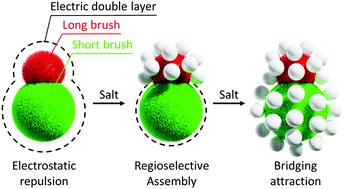当前位置:
X-MOL 学术
›
Soft Matter
›
论文详情
Our official English website, www.x-mol.net, welcomes your
feedback! (Note: you will need to create a separate account there.)
Selective colloidal bonds via polymer-mediated interactions.
Soft Matter ( IF 2.9 ) Pub Date : 2020-07-07 , DOI: 10.1039/d0sm00942c Joeri Opdam 1 , Remco Tuinier 1 , Theodore Hueckel 2 , Thom J Snoeren 2 , Stefano Sacanna 2
Soft Matter ( IF 2.9 ) Pub Date : 2020-07-07 , DOI: 10.1039/d0sm00942c Joeri Opdam 1 , Remco Tuinier 1 , Theodore Hueckel 2 , Thom J Snoeren 2 , Stefano Sacanna 2
Affiliation

|
Regioselectivity in colloidal self-assembly typically requires specific chemical interactions to guide particle binding. In this paper, we describe a new method to form selective colloidal bonds that relies solely on polymer adsorption. Mixtures of polymer-coated and bare particles are initially stable due to long-ranged electrostatic repulsion. When their charge is screened, the two species can approach each other close enough for polymer bridges to form, binding the particles together. By utilizing colloidal dumbbells, where each lobe is coated with polymer brushes of differing lengths, we demonstrate that the Debye screening length serves as a selective switch for the assembly of bare tracer particles onto the two lobes. We model the interaction using numerical self-consistent field lattice computations and show how regioselectivity arises from just a few nanometers difference in polymer brush length.
中文翻译:

通过聚合物介导的相互作用的选择性胶体键。
胶体自组装中的区域选择性通常需要特定的化学相互作用来引导颗粒结合。在本文中,我们描述了一种仅依赖于聚合物吸附而形成选择性胶体键的新方法。由于长距离静电排斥,聚合物涂层和裸露颗粒的混合物最初是稳定的。当筛选出它们的电荷时,这两种物质可以彼此靠近得足够近,从而形成聚合物桥,从而将颗粒结合在一起。通过利用胶体哑铃,其中每个瓣都涂有不同长度的聚合物刷,我们证明了德拜筛分长度可以作为将裸示踪剂颗粒组装到两个瓣上的选择性开关。
更新日期:2020-08-19
中文翻译:

通过聚合物介导的相互作用的选择性胶体键。
胶体自组装中的区域选择性通常需要特定的化学相互作用来引导颗粒结合。在本文中,我们描述了一种仅依赖于聚合物吸附而形成选择性胶体键的新方法。由于长距离静电排斥,聚合物涂层和裸露颗粒的混合物最初是稳定的。当筛选出它们的电荷时,这两种物质可以彼此靠近得足够近,从而形成聚合物桥,从而将颗粒结合在一起。通过利用胶体哑铃,其中每个瓣都涂有不同长度的聚合物刷,我们证明了德拜筛分长度可以作为将裸示踪剂颗粒组装到两个瓣上的选择性开关。











































 京公网安备 11010802027423号
京公网安备 11010802027423号